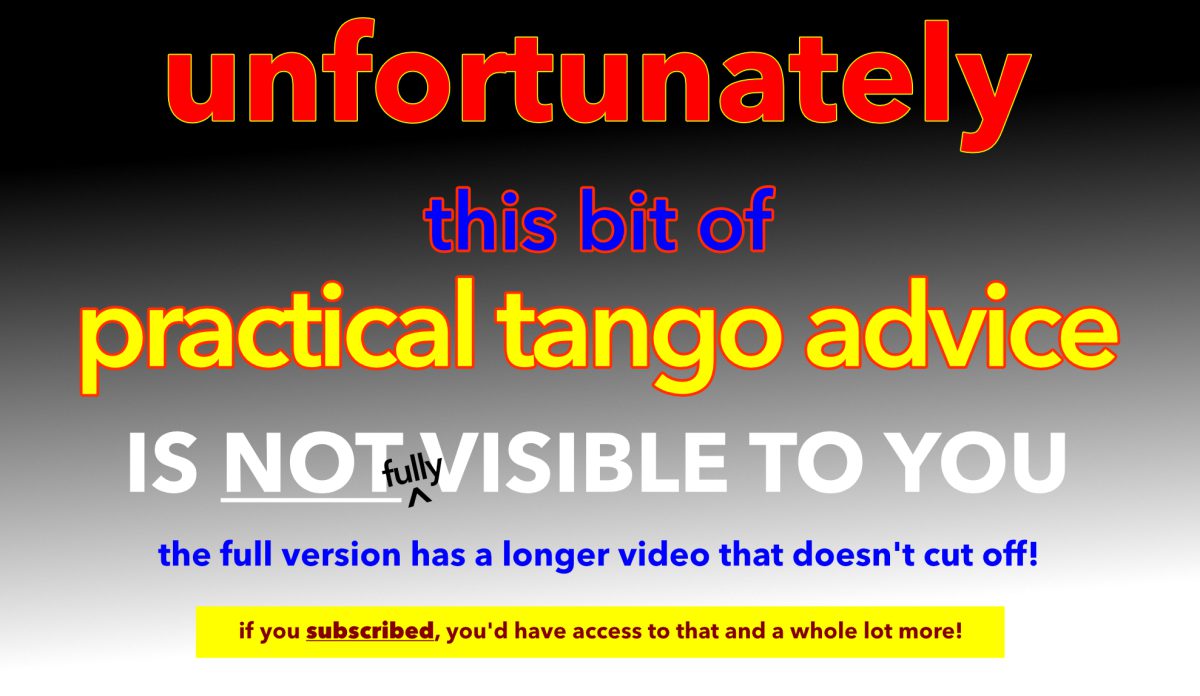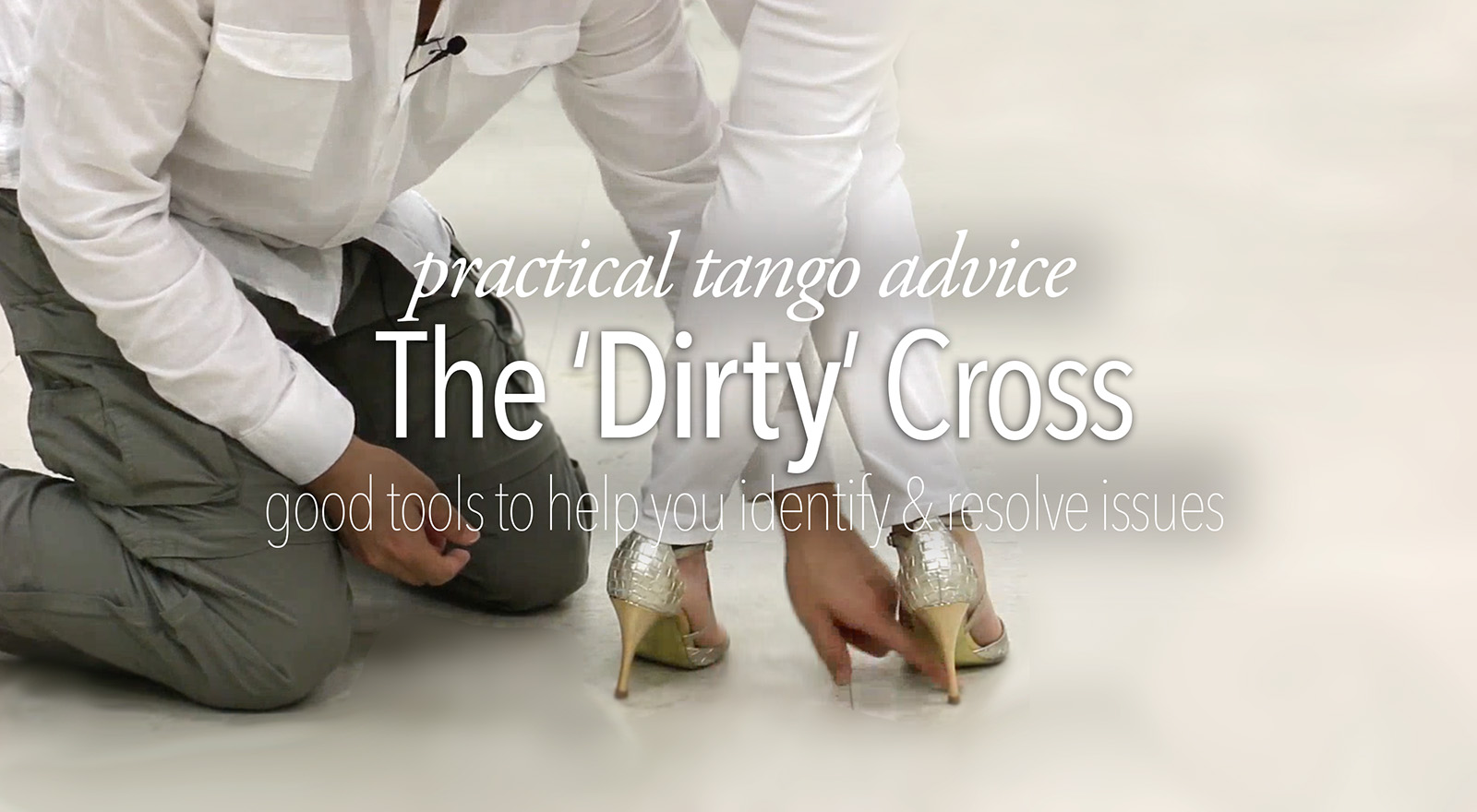The ‘Dirty’ Cross. The word ‘Dirty’ refers to a state of unkempt, or unclean state of existence. However, from a Tango perspective it has another connotation. “Dirty” refers to a less than desirable execution or ending execution a specific variety of vocabulary. And in this case, it refers to a crossed foot for either role in either the forward or back cross position. However, for the purposes of this video, it’s limited solely to the Follower’s crossing step from an Argentine Cross.
From A Following Perspective, this isn’t rocket science. It’s really a matter of diligence for you and really remembering to do it. However, remembering and doing are two very different things. The fact is that this needs to be ingrained behavior in you. And if it isn’t then we have a small problem – remembering. That means “thinking”, which is actually a good thing, but not about technique as it is happening. While we do want to think about technique, and we do want a thinking, aware, conscious, detailed, and Active Follower, we do not desire a Follower that is figuring out their technique apparatus as they are dancing with their partners in the moment. Which is to say that if you have to stop and think about X, then you’re going to miss some rather important details that are going on because you’re focused on X. Where ‘X’ is whatever piece of technique you’re thinking about. The human mind is only capable of doing so much, and more than or two things at a time is a stretch for most people. Dancing AND thinking about technique AND doing technique in the moment ? Good luck with that. Which isn’t to say that it’s impossible, it’s just ‘challenging’. So why make things more difficult for yourself ? Instead, here’s a thought: Make a clean cross your default, goto behavior for yourself!
How do you make this default behavior ? Simple. Practice. Practice. Practice. It’s not rocket science. It’s a matter of practice. To be clear, you do not need to schedule practice time with a partner, or in a studio. No. Less than desirable thinking. Better thinking is: On the way to work, standing & talking to someone, standing in line, in your kitchen, anywhere really. Practice with a partner in this case is not going to help you. This is about retraining yourself in solo practice when you have the time. If you want to set aside a few minutes a day to remind yourself to do this, that’s great! Do that! However, the reality is that this is solo work, and you don’t need anyone else. This is your technique, not someone else’s. This is how you respond when X is led, and rightfully you’re trying to change the underlaying response from ‘dirty’ to ‘clean’. The more that you do this, the more that it will show up in your dance!
From a Leading Perspective, you’ve got nothing on this, from a Following perspective. This is not something you can really ‘lead’. You can intend, you can suggest, you can invite, but the fact of the matter is that a.) The Follower has to be listening. b.) The Follower must be physiologically & neurologically aware. and c.) The ‘Free’ Leg must be available for you to ‘Lead’ a Clean Cross. That said, the reality is that you’re not going to do much here except for inviting the Follower to be as diligent with their crosses as is humanly possible. One way that we can help to create a viable working platform for that to happen is to remove all the physiological ‘noise’ that we as Leads can generate. Like for instance, unintended motion, stopping a ‘move’ as it’s happening. Still another is compressing the living daylights out of your partners. Still another is being an unclear lead, meaning that you intend to something that you think is so crystal clear when in fact it isn’t. It’s wishy-washy at best! We, as leads, have a responsibility to be as crystal clear with our Followers as possible but at the same time creating space for them to execute what we ask for, while at the same time, listening for that response and not forcing them to do X, Y, and Z. So as much as you would like to control a ‘Clean’ cross out of your Follower, the reality is that a good portion of the time you’re going to get a ‘Dirty’ cross for a variety of reasons. One of them has to do with how and where you have placed the Follower in the embrace (Your armpit). Still another has to do with stepping out and away from them in a parallel or cross system cross. 🙁 And a few others. In the end, you have no control over how the Follower executes what you ask, the best you can do is cajole, invite, engage, but never, ever force.
Aside from leading the Follower to do ‘X’, you can and do generate a fair amount of unclean crosses on your own when you’re engaging Lead Enrosques! These are back crosses that when done properly can really enhance the visual lines of the couple and adds a bit of leading flash to the couple dynamic. However if you’re engaging in a ‘Dirty’ back cross it ruins the visual effect of the Enrosque. So ? We ideally want clean, very tight, crisp crosses!
From a Dancing Perspective both roles can and do generate this issue. It’s a matter of cleanliness, detailed technique practice, and solo practice, diligence really. Just because this video exists, is this going to change what you’re doing ? No. Are you going to suddenly, automagically change your dancing habits ? No. The reality is that you’re going to keep doing what you’re doing because it’s comfortable for you. Is that desirable ? No. But that doesn’t matter. The only way that you’re going to change what you’re doing is through force of will. A desire to change your dancing habits. Doing that can change everything about your dance. Right now, a ‘Dirty’ cross is your default behavior. With a little time and patience it can become a thing of the past. Setting you on the road to a cleaner, clearer, visually appealing dancer. The fact is that there are certain things about dancing with new people, certain things we look for in their dance that says ‘desirable’. This is one of them. While you may not want to admit it yourself, when you see cleanliness in someone’s dance, the fact is that you’re drawn to it. This is one of those areas where you have to be diligent, as that diligence pays off in getting more and more dances. 😉
The Free Tip. Stop. Doing. This. 🙂 In all seriousness this is simple matter of the following: “PRACTICE”. Failure to practice this stuff, and you end up with less than desirable. It’s that simple.

The Soup. Typically as a paying subscriber you would see some things here that are either missing in the video, or some other details that the video implies or does not make absolutely clear. However, because this an open version of Practical Tango Advice, you’re seeing all of it here. 😉 Enjoy this free preview of today’s Practical Tango Advice, and remember that this is just a small sample of what else is behind the the paywall of Tango Topics. There’s over 250+ videos, over 1000 pieces of tango music, videos to help you understand the music and what to listen for, tests, quizzes, exercise videos, all for one low fee. Consider either subscribing today or upgrading your subscription!

